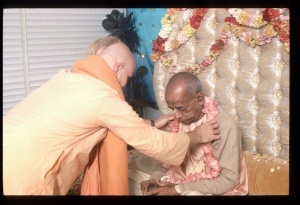BG 2.58: Difference between revisions
m (1 revision(s)) |
(Vanibot #0020 edit - link to the Version Compare feature) |
||
| Line 1: | Line 1: | ||
{{ | [[Category:Bhagavad-gita As It Is (1983+) - Chapter 02]] | ||
<div style="float:left">'''[[Bhagavad-gita As It Is (1983+)]] - [[BG 2 (1983+)|Chapter 2: Contents of the Gita Summarized]]'''</div> | |||
<div style="float:right">[[File:Go-previous.png|link=BG 2.57]] '''[[BG 2.57]] - [[BG 2.59]]''' [[File:Go-next.png|link=BG 2.59]]</div> | |||
{{CompareVersions|BG|2.58|BG 1972|BG 1983+}} | |||
{{RandomImage}} | |||
==== TEXT 58 ==== | ==== TEXT 58 ==== | ||
<div class="devanagari"> | |||
:यदा संहरते चायं कूर्मोऽङ्गानीव सर्वशः । | |||
:इन्द्रियाणीन्द्रियार्थेभ्यस्तस्य प्रज्ञा प्रतिष्ठिता ॥५८॥ | |||
</div> | |||
<div | <div class="verse"> | ||
:yadā saṁharate cāyaṁ | |||
:kūrmo 'ṅgānīva sarvaśaḥ | |||
:indriyāṇīndriyārthebhyas | |||
:tasya prajñā pratiṣṭhitā | |||
</div> | </div> | ||
==== SYNONYMS ==== | ==== SYNONYMS ==== | ||
<div class="synonyms"> | |||
<div | ''yadā''—when; ''saṁharate''—winds up; ''ca''—also; ''ayam''—he; ''kūrmaḥ''—tortoise; ''aṅgāni''—limbs; ''iva''—like; ''sarvaśaḥ''—altogether; ''indriyāṇi''—senses; ''indriya-arthebhyaḥ''—from the sense objects; ''tasya''—his; ''prajñā''—consciousness; ''pratiṣṭhitā''—fixed. | ||
</div> | </div> | ||
==== TRANSLATION ==== | ==== TRANSLATION ==== | ||
<div class="translation"> | |||
<div | |||
One who is able to withdraw his senses from sense objects, as the tortoise draws its limbs within the shell, is firmly fixed in perfect consciousness. | One who is able to withdraw his senses from sense objects, as the tortoise draws its limbs within the shell, is firmly fixed in perfect consciousness. | ||
</div> | </div> | ||
==== PURPORT ==== | |||
= | <div class="purport"> | ||
The test of a ''yogī'', devotee, or self-realized soul is that he is able to control the senses according to his plan. Most people, however, are servants of the senses and are thus directed by the dictation of the senses. That is the answer to the question as to how the ''yogī'' is situated. The senses are compared to venomous serpents. They want to act very loosely and without restriction. The ''yogī'', or the devotee, must be very strong to control the serpents—like a snake charmer. He never allows them to act independently. There are many injunctions in the revealed scriptures; some of them are do-not's, and some of them are do's. Unless one is able to follow the do's and the do-not's, restricting oneself from sense enjoyment, it is not possible to be firmly fixed in Kṛṣṇa consciousness. The best example, set herein, is the tortoise. The tortoise can at any moment wind up its senses and exhibit them again at any time for particular purposes. Similarly, the senses of the Kṛṣṇa conscious persons are used only for some particular purpose in the service of the Lord and are withdrawn otherwise. Arjuna is being taught here to use his senses for the service of the Lord, instead of for his own satisfaction. Keeping the senses always in the service of the Lord is the example set by the analogy of the tortoise, who keeps the senses within. | |||
</div> | |||
<div | <div style="float:right; clear:both;">[[File:Go-previous.png|link=BG 2.57]] '''[[BG 2.57]] - [[BG 2.59]]''' [[File:Go-next.png|link=BG 2.59]]</div> | ||
__NOTOC__ | |||
</div> | __NOEDITSECTION__ | ||
__NOTOC__ | |||
Revision as of 21:12, 7 December 2017

A.C. Bhaktivedanta Swami Prabhupada
TEXT 58
- यदा संहरते चायं कूर्मोऽङ्गानीव सर्वशः ।
- इन्द्रियाणीन्द्रियार्थेभ्यस्तस्य प्रज्ञा प्रतिष्ठिता ॥५८॥
- yadā saṁharate cāyaṁ
- kūrmo 'ṅgānīva sarvaśaḥ
- indriyāṇīndriyārthebhyas
- tasya prajñā pratiṣṭhitā
SYNONYMS
yadā—when; saṁharate—winds up; ca—also; ayam—he; kūrmaḥ—tortoise; aṅgāni—limbs; iva—like; sarvaśaḥ—altogether; indriyāṇi—senses; indriya-arthebhyaḥ—from the sense objects; tasya—his; prajñā—consciousness; pratiṣṭhitā—fixed.
TRANSLATION
One who is able to withdraw his senses from sense objects, as the tortoise draws its limbs within the shell, is firmly fixed in perfect consciousness.
PURPORT
The test of a yogī, devotee, or self-realized soul is that he is able to control the senses according to his plan. Most people, however, are servants of the senses and are thus directed by the dictation of the senses. That is the answer to the question as to how the yogī is situated. The senses are compared to venomous serpents. They want to act very loosely and without restriction. The yogī, or the devotee, must be very strong to control the serpents—like a snake charmer. He never allows them to act independently. There are many injunctions in the revealed scriptures; some of them are do-not's, and some of them are do's. Unless one is able to follow the do's and the do-not's, restricting oneself from sense enjoyment, it is not possible to be firmly fixed in Kṛṣṇa consciousness. The best example, set herein, is the tortoise. The tortoise can at any moment wind up its senses and exhibit them again at any time for particular purposes. Similarly, the senses of the Kṛṣṇa conscious persons are used only for some particular purpose in the service of the Lord and are withdrawn otherwise. Arjuna is being taught here to use his senses for the service of the Lord, instead of for his own satisfaction. Keeping the senses always in the service of the Lord is the example set by the analogy of the tortoise, who keeps the senses within.